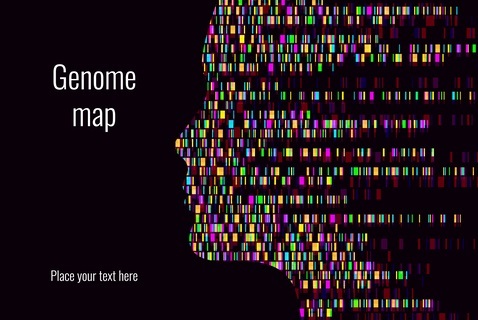
 Data Structure
Data Structure Networking
Networking RDBMS
RDBMS Operating System
Operating System Java
Java MS Excel
MS Excel iOS
iOS HTML
HTML CSS
CSS Android
Android Python
Python C Programming
C Programming C++
C++ C#
C# MongoDB
MongoDB MySQL
MySQL Javascript
Javascript PHP
PHP
- Selected Reading
- UPSC IAS Exams Notes
- Developer's Best Practices
- Questions and Answers
- Effective Resume Writing
- HR Interview Questions
- Computer Glossary
- Who is Who
Gene Mapping for Qualitative and Quantitative Traits
Introduction
Gene mapping is a critical process in modern genetics that involves identifying the locations of genes on chromosomes. This process can be used to study both qualitative and quantitative traits, which are two types of traits that vary in their patterns of inheritance. Qualitative traits are traits that are controlled by one or a few genes and are usually expressed in discrete categories, such as eye colour or blood type.
Quantitative traits, on the other hand, are traits that are controlled by multiple genes and are usually expressed in a continuous range of values, such as height or weight. In this article, we will explore gene mapping for both qualitative and quantitative traits, including the methods used, the challenges involved, and the applications of this technique.
Gene Mapping for Qualitative Traits
Qualitative traits are relatively easy to study because they are controlled by one or a few genes. To map the genes responsible for a qualitative trait, researchers typically use a method called linkage analysis. Linkage analysis involves comparing the patterns of inheritance of the trait with the patterns of inheritance of known genetic markers, such as single nucleotide polymorphisms (SNPs) or microsatellites.
By analysing the co-inheritance of the trait and the genetic markers in families, researchers can determine which markers are linked to the trait and therefore likely to be located near the gene that controls the trait.
Once a genetic marker is linked to a qualitative trait, researchers can use additional methods, such as positional cloning, to identify the specific gene responsible for the trait. Positional cloning involves narrowing down the location of the gene by analysing the DNA of individuals with the trait and comparing it to the DNA of individuals without the trait. By looking for differences in the DNA sequences between the two groups, researchers can identify the specific gene that is responsible for the trait.
One example of gene mapping for a qualitative trait is the mapping of the gene responsible for Huntington's disease. Huntington's disease is a degenerative neurological disorder that is caused by a mutation in the huntingtin (HTT) gene. Researchers used linkage analysis to link the disease to a specific region of chromosome 4, and then used positional cloning to identify the HTT gene as the specific gene responsible for the disease. This discovery has led to new treatments and insights into the disease.

Gene Mapping for Quantitative Traits
Quantitative traits are more complex than qualitative traits because they are controlled by multiple genes, as well as environmental factors. To map the genes responsible for a quantitative trait, researchers typically use a method called quantitative trait locus (QTL) mapping.
QTL mapping involves comparing the phenotypes of individuals with different genetic markers to identify regions of the genome that are associated with the trait.
There are two main types of QTL mapping ?
Interval Mapping.
Association Mapping.
Interval mapping involves analyzing the co-inheritance of the trait and genetic markers in a set of related individuals to identify regions of the genome that are linked to the trait. Association mapping, on the other hand, involves analyzing the correlation between the trait and genetic markers in a population of unrelated individuals to identify regions of the genome that are associated with the trait.
One example of gene mapping for a quantitative trait is the mapping of the genes responsible for height. Height is a complex trait that is influenced by multiple genes, as well as environmental factors such as nutrition and exercise.
Researchers have used QTL mapping to identify several regions of the genome that are associated with height, and have also used fine mapping to narrow down the location of specific genes within these regions.
Some of the genes identified as being associated with height include the growth hormone gene (GHR), the insulin-like growth factor 1 gene (IGF1), and the fibroblast growth factor receptor 3 gene (FGFR3).

Challenges in Gene Mapping
While gene mapping is a powerful tool for studying the genetic basis of traits, there are several challenges that researchers must overcome in order to successfully map genes. One of the biggest challenges is the complexity of many traits, particularly quantitative traits, which are influenced by both genetic and environmental factors. This complexity can make it difficult to identify the specific genes that are responsible for a given trait.
Another challenge is the need for large sample sizes in order to detect significant associations between genetic markers and traits. This is particularly true for association mapping, which requires large populations of individuals in order to have sufficient statistical power to identify significant associations.
The third challenge is a difficulty in distinguishing between causative genes and genes that are simply correlated with the trait of interest. In order to determine whether a gene is truly responsible for a trait, researchers must use additional methods, such as functional studies or gene editing, to demonstrate a causal relationship between the gene and the trait.
Applications of Gene Mapping
Despite the challenges involved, gene mapping has a wide range of applications in both basic and applied research. In basic research, gene mapping is used to understand the genetic basis of traits and to study the evolution of genetic variation.
In applied research, gene mapping is used to identify genes that are associated with a disease or other traits of interest, which can lead to the development of new treatments or interventions.
One of the most important applications of gene mapping is in the field of personalized medicine. By identifying the specific genetic variants that are associated with a particular disease or trait, researchers can develop personalized treatments that are tailored to the individual patient's genetic profile. This approach has already been used successfully in the treatment of some types of cancer, where genetic testing is used to identify mutations that can be targeted with specific drugs.
Another application of gene mapping is in the development of genetically modified organisms (GMOs). Gene mapping can be used to identify genes that are responsible for desirable traits, such as disease resistance or increased yield, and these genes can then be introduced into other organisms to create new strains with these traits. This approach has been used extensively in agriculture, where GMO crops have been developed to resist pests or tolerate environmental stress.
Conclusion
Gene mapping is a powerful tool for studying the genetic basis of both qualitative and quantitative traits. By identifying the specific genes that are responsible for a trait, researchers can gain insights into the underlying biology of the trait and develop new treatments or interventions.
While there are many challenges involved in gene mapping, including the complexity of many traits and the need for large sample sizes, advances in technology and methodology have made this approach more accessible than ever before.
As we continue to unravel the mysteries of the genome, gene mapping will undoubtedly play an increasingly important role in both basic and applied research.

